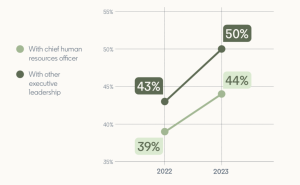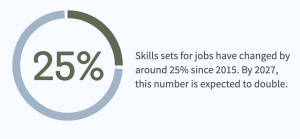For those who may not have seen it yet, LinkedIn’s recent 2023 Workplace Learning Report contained some pretty interesting data.
A huge positive is the extent to which L&D’s “time in the spotlight” is quite literally now – with data showing the percentage of L&D professionals working directly with C-Suite leaders has grown considerably in the last year. Some 44% now work with the chief HR officer; while 50% now work directly with other executive leaders (see below):

This – plus the fact 82% of global leaders now agree the HR function is more critical now than it has ever been – ought to be causes for celebration.
However, what the LinkedIn data also revealed is the fact that the skills required by people to do their jobs have changed by a massive 25% since just 2015. Not only that, by as soon as 2027, this percentage is expected to double.

Not surprisingly, upskilling and reskilling their workforce has become a huge priority for leaders – and learning budgets are up correspondingly, as companies scramble to bridge their skills gaps and prepare for the future.
The problem however, is that just when companies want to upskill their staff faster, it’s becoming less easy to convince employees of the need to take on extra training – especially if they feel it is not directly connected to their day-to-day work.
So how can this problem be solved?
It’s essential training is reframed as something that is going to help employees reach their goals, rather than impede them by taking away time from their current tasks at hand.
L&D leaders excel at creating ROI for the company with their training programs, but the ROI for employees is just as important, if not more so. But a company won’t feel the positive impacts of a training program if too few employees adopt it.
One reliable way to make these programs more valuable to employees is to ensure their completion is marked with a digital credential.
These verifiable digital badges and certificates can unlock a world of new professional opportunities for employees, making them a powerful incentive for training adoption and completion. They also give leaders a clearer picture of a team’s existing skills.
So let’s examine the warning signs of a struggling corporate training program – and how digital credentials can help get things back on track:
There’s currently little reward
In an ideal world, every employee would jump at the chance to get additional training on the job. But most of the time, this is not going to be the case. Everyone learns differently, and structured corporate training won’t match with every learning style. But more than this is the real struggle around inspiring people and motivating people for learning. Employees need some sort of incentive for their hard work, more than just the satisfaction of a new skill, or else they won’t see the value in the effort.
Digital credentials offer this value, as they can unlock a wealth of career growth opportunities when conferred upon completion of a course. Stacking digital credentials can give employees access to new positions and departments, or even allow them to specialize more deeply in their current roles, expanding their value to the company. They’re also a powerful branding tool, since employees can share them on social media.
Digital credentials can also slot into existing employee rewards and recognition programs. For example, employees who obtain a certain credential by a certain deadline could be eligible for a spot bonus.
Credentials can also be a part of the conditions for a raise or promotion. This not only makes it easier for leaders to make promotion decisions, but can even remove bias from the process, as credentials provide verifiable proof of skills earned through objective assessments, reducing reliance on more subjective criteria.
There’s currently little accountability
In an ideal world accountability systems should be rooted in encouraging employees to find the value in their training programs and see them to completion – not punishing them if they don’t. But that’s not often the case.
Digital credentials help employees find this missing value. When you can promise employees a career-advancing certification, you provide a much stronger incentive for completing a course of training.
Beyond verifying proficiency in a skill, digital credentials offer a way to bolster an employee’s personal brand. The way people market themselves online plays a crucial role in how their employers perceive them, and with digital credentials, they can bolster their own brands with legitimate qualifications.
Furthermore, it’s easy to track progress toward a specific credential, allowing managers to diagnose when and where their reports are falling behind. That way, they can course-correct early and keep employees on track for success.
There’s currently little time
Learning time should be protected, just like meeting slots and blocks of deep work, but while managers can help employees shuffle their priorities, coursework must be digestible in the first place.
This is why micro-credentials are an effective way to certify employees in new skills.
By allowing employees to earn one small credential at a time, building to a larger certificate, micro-credentials integrate far more flexibly with busy employees’ schedules than traditional training programs, making it easier for them to complete additional training on top of their daily tasks.
Employees don’t currently see the practical application
People won’t want to participate in a training program if they can’t see how it directly connects to their job.
This requires employers to first assess if they’ve chosen the right training tracks in the first place. Training employees in skills they won’t use or can’t see themseives applying to their everyday roles is a recipe for failure.
Then comes the challenge of communicating the value of the training to employees’ individual roles – and believe it or not, digital credentials can do much of the legwork.
Digital credentials contain important information, called metadata, that communicates the significance of a credential and how it can be used to advance an employee’s career.
Potential metadata includes coursework portfolios, related courses, new roles employees will qualify for, and even salary ranges for workers with that credentia – all of which can clarify ambiguities around the value of a particular course.
Moreover, keeping a digital credentials database can help you identify where to prioritize training, so employees feel they’re learning something that will actually make their jobs easier.
When you have access to employees’ earned credentials and skills in one single, verifiable location, it’s easier to see where there may be gaps.
Top leaders aren’t often involved
When it comes to upskilling the workforce, leaders shouldn’t be hands-off. Not just because they’re key decision-makers, but because they play a pivotal role in boosting morale.
When employees see that top executives at the company are invested in their learning, they’re going to feel empowered to keep at it. In fact, a recent survey showed that nearly a third of workers value recognition from executive leaders above any other group in the workplace.
Companies might want to consider establishing a Credential Manager role to oversee training success, to help develop a credentialing playbook and manage the employee skill database.
This individual, who would work directly with employees to ensure they’re getting the full ROI of their training program, would then become a driving force in improving employee growth and retention.
The workplace is ever-changing, and as the demand for new skills soars, corporate training programs will become increasingly important to the health of your business.
Don’t miss the early signs if your training efforts are faltering – and if you’re just getting started, use digital credentials as a foundation for success.